Contents
- Introduction
- What people don’t know about motorbikes
- What can a Tigit motorbike carry
- Example gear for a long journey
- What backpackers normally wear
- Consideration on lights
- Deciding on the style of holiday you are going for
- Packing electronic gear and laptops
- Rain gear
- Safety Gear
- Helmet Rentals
- Jacket, Knee and Elbow Protectors Rentals
- The Weather and How To Plan For It
- Water & Staying Hydrated
- Things To Consider:
Introduction
When traveling on a motorbike, you should be traveling as lightly as possible. Small 100+cc motorbikes can and will carry you and a mountain of luggage across any road in Vietnam. However, the motorbike will become increasingly shaky and unstable with every kilogram added to your load. This reduces performance and therefore reduces enjoyment while also reducing safety.
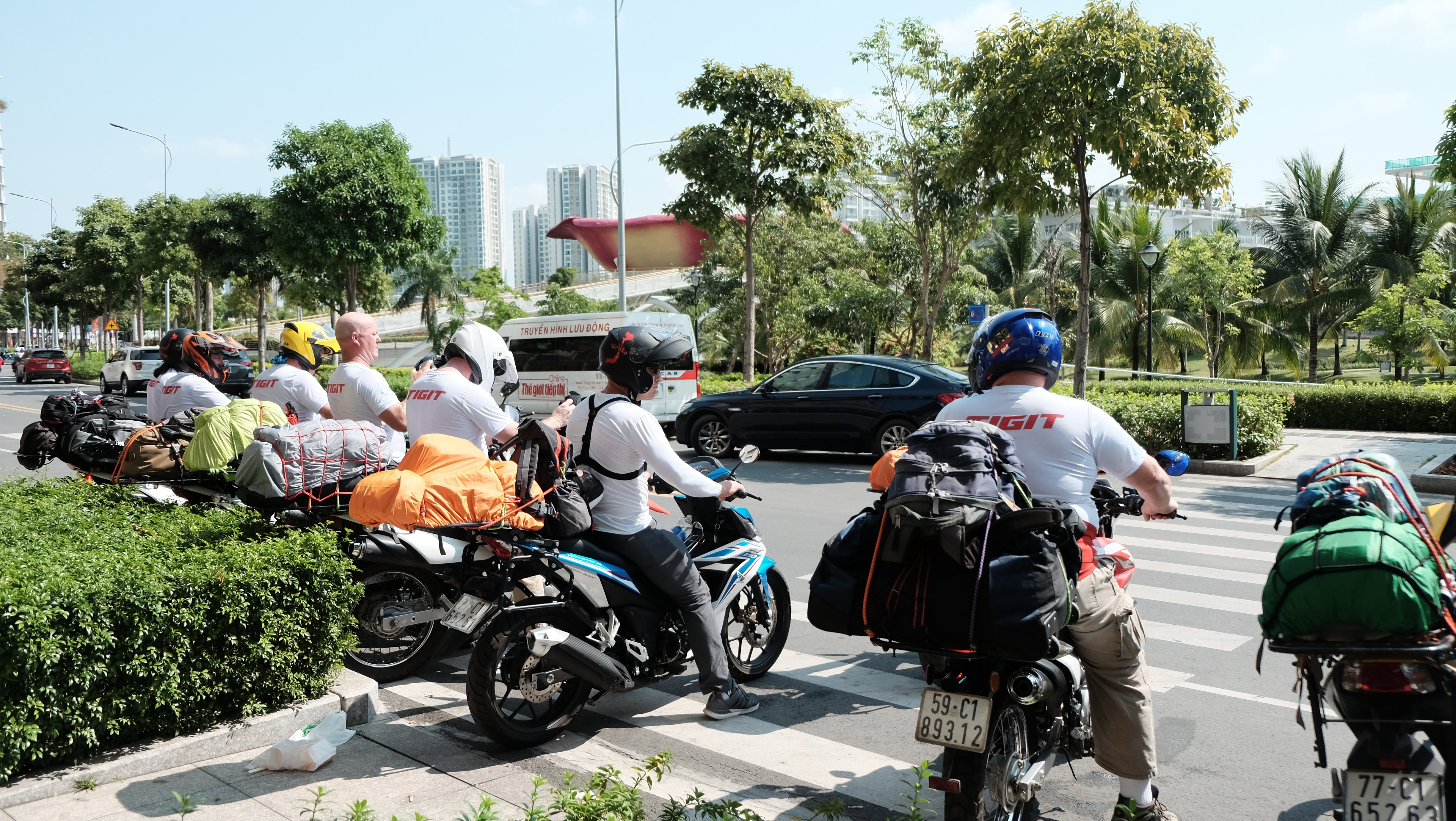
What people don’t know about motorbikes
Motorbikes are not large vehicles and are carefully designed based on the average weight the manufacturer believes will be on the motorbike. Altering this weight will dramatically change the performance of the vehicle. It is common to see adventure pictures with motorbikes piled up to the maximum with hard boxes and camping gear combined with a rugged-looking adventure man heading off deep into the outback.
In reality, “true” motorcyclists know that weight is critical and won’t use hard boxes or heavy gear on their big journeys. Soft saddlebags if they must carry gear, and an attitude toward dirty, light, and economical traveling.
Weight is important, and removing it should be done at all costs. The enjoyment lost through a boat-handling overloaded motorbike is easily worth the trade-off of choosing carefully selected gear and having a motorbike performing under its stock weight limits.
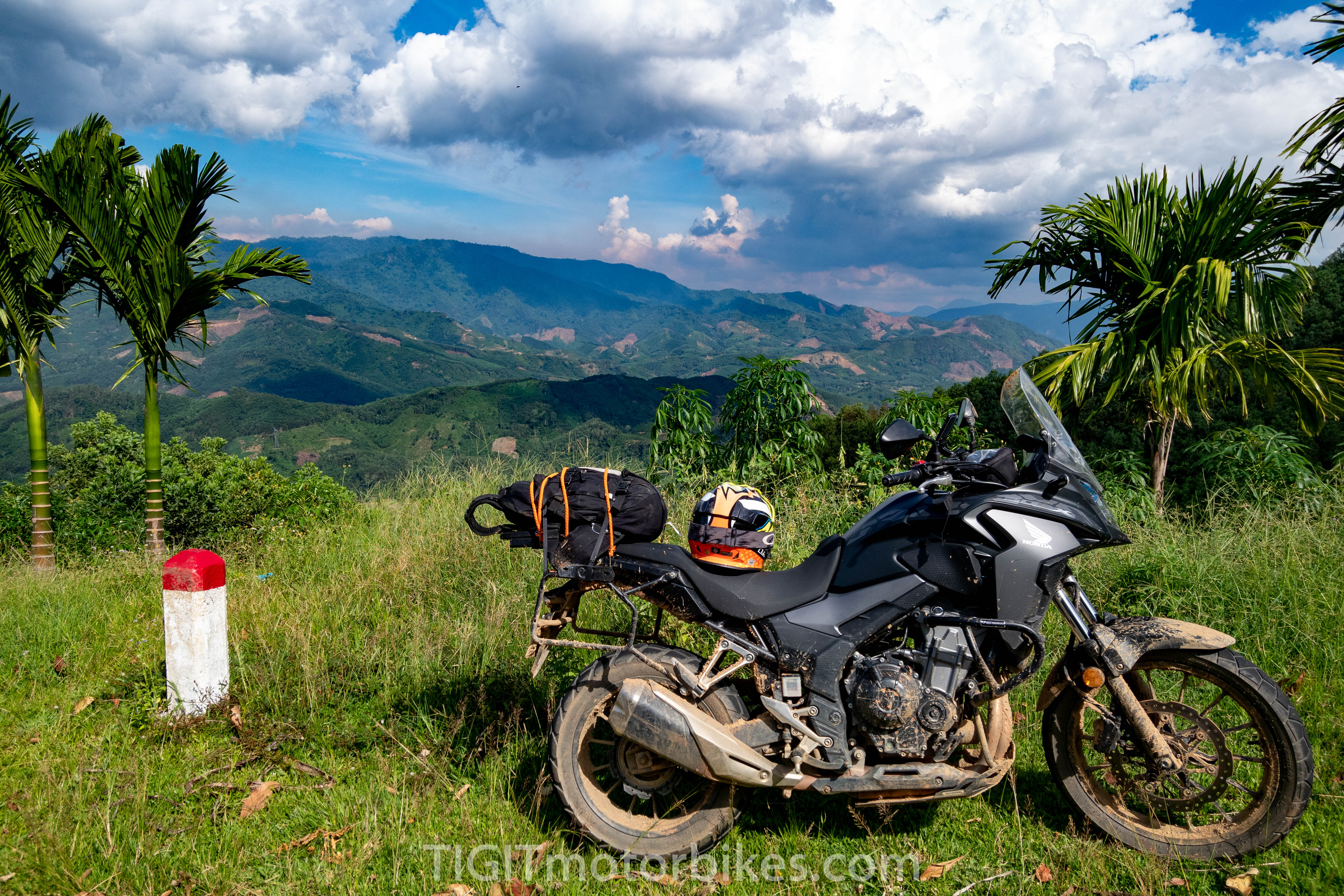
What can a Tigit motorbike carry
Overall: We Recommend A MAXIMUM 15kg of luggage
Choosing the correct motorbike is important for enjoying the journey across Vietnam. Your luggage load is likely to impact your decision on the motorbike model. Larger capacity motorbikes such as the Honda CB 500x can cater to heavier loads without massively impacting performance.
The small 110cc motorbike can carry anything, but the performance shift in handling will be noticeable. If you must carry a load of luggage, then it is still possible to travel on a 110cc motorbike. It’s just not technically specified for it.
Tigit has a service where it is possible to send a bag from one office to another for $15-20 per bag.
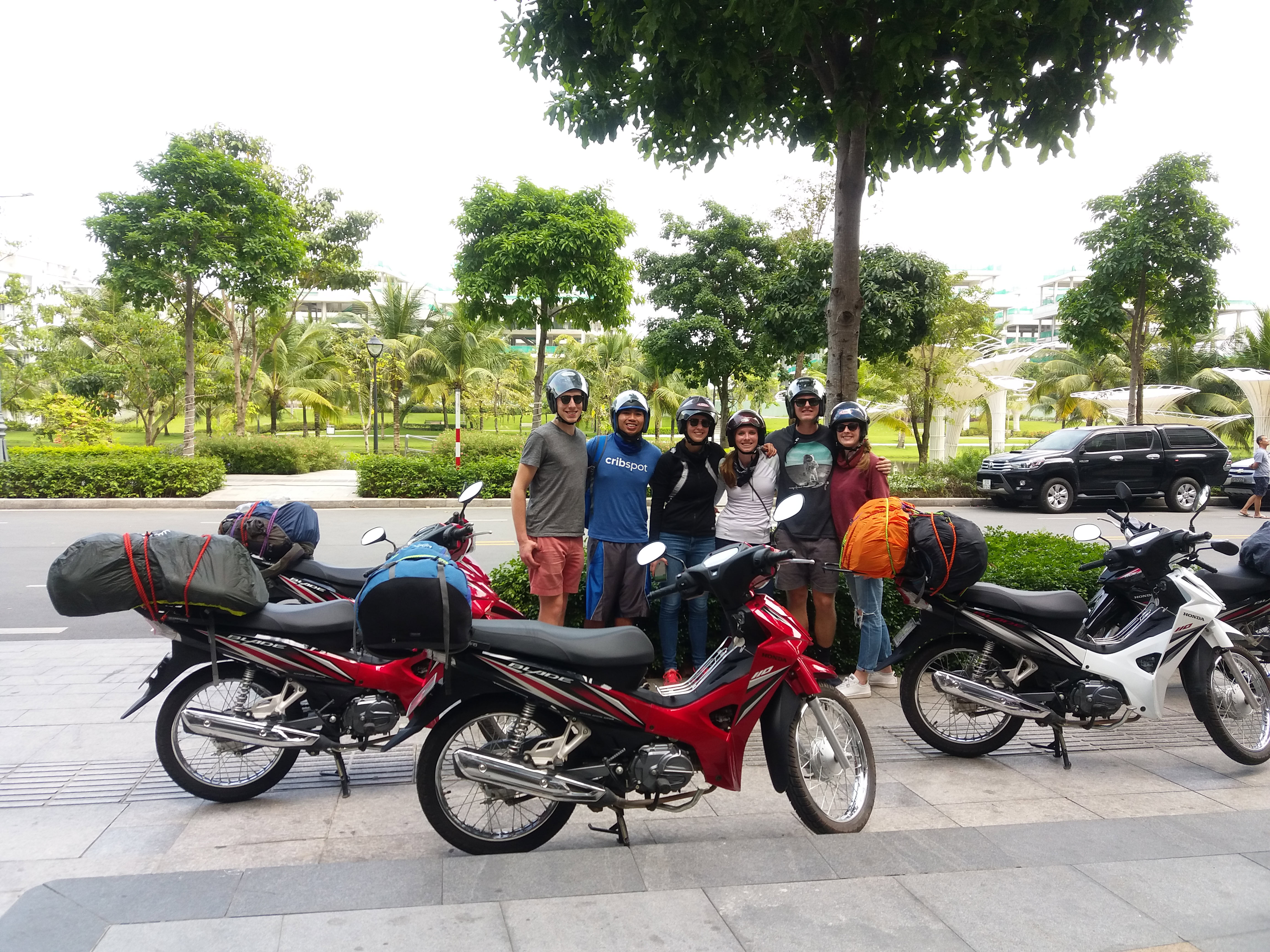
Example gear for a long journey
A holiday from one week to an unlimited amount of time should have similar setups in terms of gear. Use hotel cleaning services as you go and keep recycling your clothes. Below is an example of Tigit Jon on a 14 day trip to the Himalayas in India. The Himalayas has far more volatile weather fluctuations than Vietnam, and the gear below could be considered overkill for Vietnam. Take a look, and consider how small and simple this is.
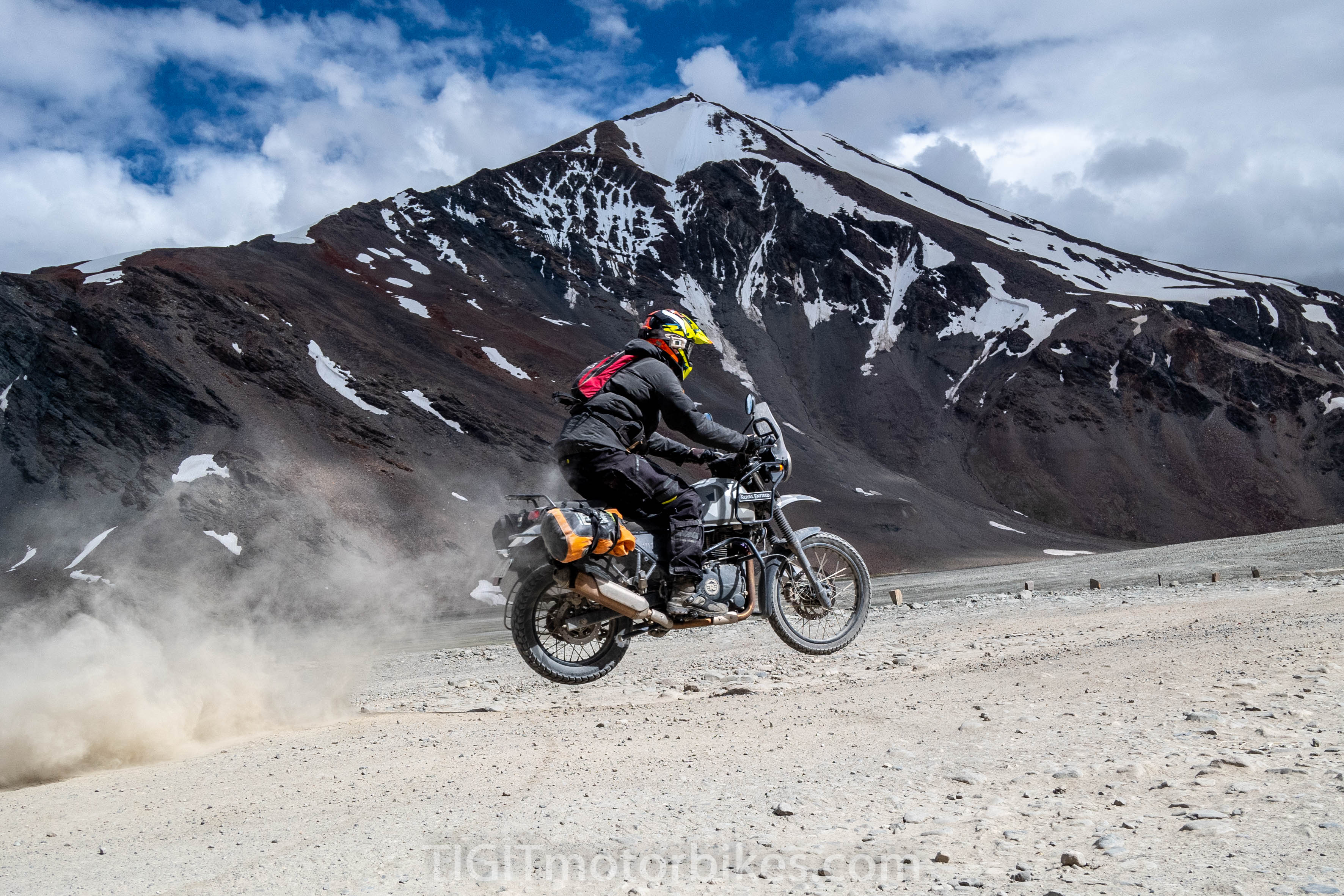
Tigit Jon on a 14 day trip in the Himalayas
- 1 x head torch
- 3 x socks (two for driving, one for evening)
- 1 x ADV boots
- 1 x trainers (evening wear)
- 4 x boxers
- 1 x shorts (evening wear)
- 1 x thermal pants
- 1 x Fleeced trousers (backup cold wear/evening wear)
- 1 x thermal shirt
- 1 x rain pants
- 1 x ADV pants
- 3 x Motorbike shirts
- 1 x t-shirt (evening wear)
- 1 x Fleece (hoody) (evening wear)
- 1 x Gore-Tex jacket
- 1 x Knee pads
- 1 x Elbow pads
- 2 x Motocross gloves
The above will weigh less than 15KG and easily fit into 2 small bags that can attach to any motorbike. The bags Jon uses are 12L in total.
Fully suited up this will be 4 layers.
Bottom half in packing order
Thermal pants, fleeced trousers, rain pants, Adv pants
Top half in packing order
Thermal shirt, Motocross shirt, Fleeced hoody, Gore-Tex jacket.
Tigit Jon on a one week drive or less in Vietnam
- 1 x head torch
- 3 x socks (two for driving, one for the evening)
- 1 x ADV boots
- 1 x trainers (evening wear)
- 4 x boxers
- 1 x shorts (evening wear)
- 1 x rain pants
- 1 x ADV pants
- 2 x Motorbike shirts
- 1 x t-shirt (evening wear)
- 1 x lightweight rain jacket
- 1 x Knee pads
- 1 x Elbow pads
- 1 x Motocross gloves
Things to consider
The two setups are similar despite the significant journey length differences. The Himalayan kit Tigit Jon is using could easily be used for any 3-month journey.
Also, note the use of under-armor safety gear in the form of kneepads and elbow pads. Traditional ADV gear, such as ADV jackets, are heavy, expensive, and not flexible to weather fluctuations.
Under armor (used by motocross and Enduro riders) is much cheaper, much safer, and allows you to use any normal clothing over the top.
Tigit Jon will wear the same 1 x Trousers and 1 x Motocross shirt for the entire journey regardless of length. The reason for 3 x Motocross shirts is the risk of one getting wet. T-shirts can also be layered to provide warmth when it gets cold.
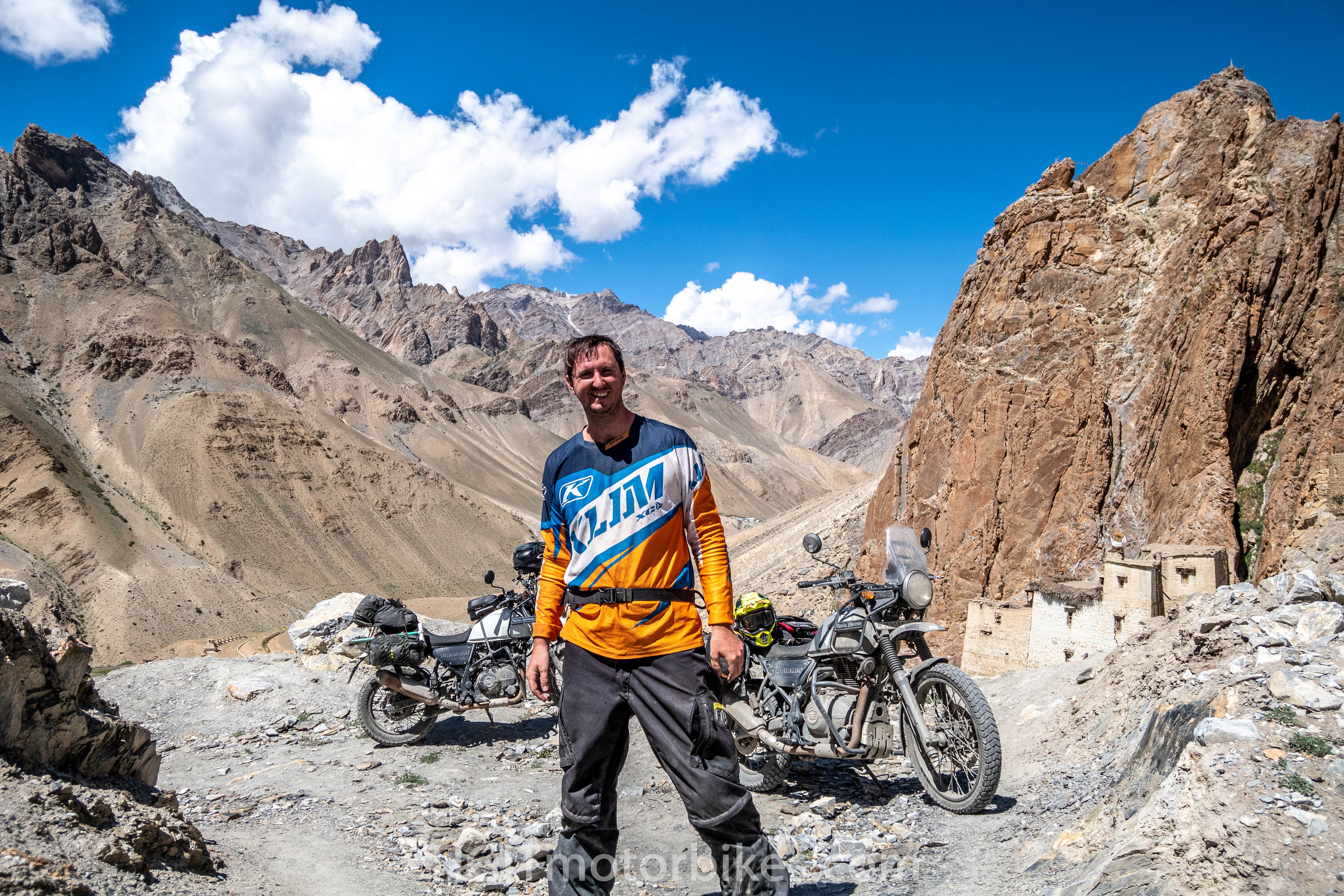
What backpackers normally wear
Most travelers will drive Vietnam in sandals, shorts, and a t-shirt. If you’re riding 3 minutes from your hostel to the beach, OK, this riding attire will suffice. Anything else, and you should not consider bare skin as ample protection.
An experienced motorcycle rider will occasionally bring all the safety gear from home. Gore-Tex riding pants, kevlar jackets with armor, knee-high riding boots, you get the picture. This attire is extreme for safety gear in Vietnam, just like a bikini is the extreme opposite. That heavy gear is going to be hot, sweaty, and overkill. You’ll find your riding here much more subdued than back home. Forget carrying all that gear around. Find some middle ground on safety and protection.
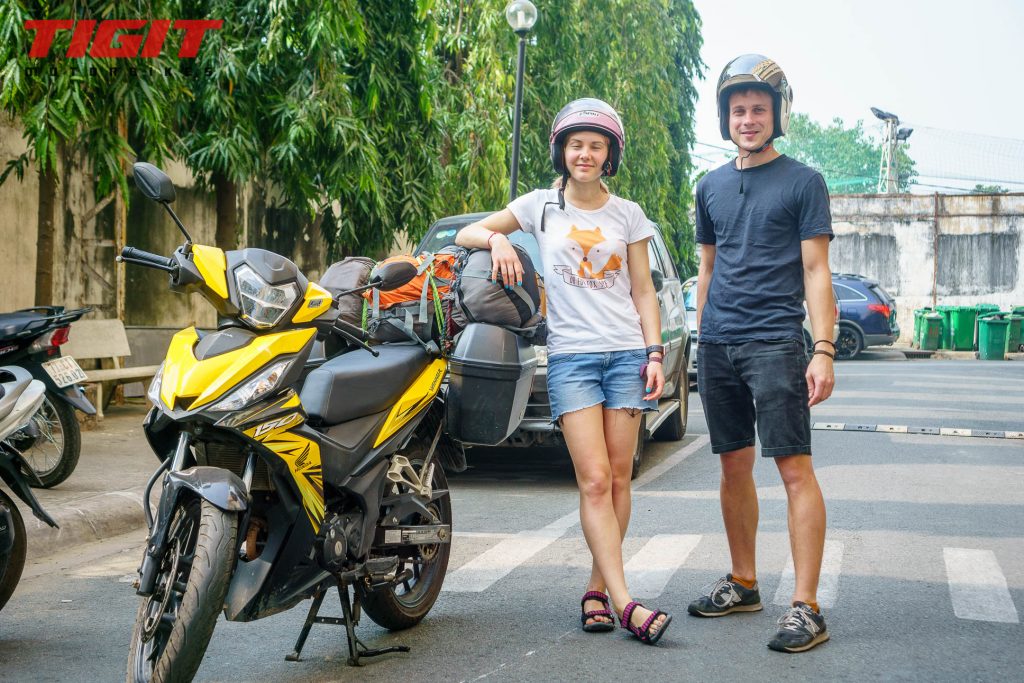 Typical riding gear in Vietnam used by most backpackers.
Typical riding gear in Vietnam used by most backpackers.
Consideration on lights
One of the biggest complaints we have at Tigit is that the motorbike lights need to be improved. Unfortunately, the real world does not work like Instagram pictures, and it is tough to gear a motorbike up with LED lights or Auxillary lights.
Yes, it is possible, but these setups tend to be hack jobs and don’t reliably work over time.
Tigit tries very hard to keep the motorbikes reliable, which means staying as close to OEM as possible. The experienced riders out there will understand. However, the less experienced riders will be confused by the simplicity of our setups!
The simple solution to the problem is to carry LED head torches. Get any torch that you would find in a camping setup. When you pick up the motorbike, spend some time figuring out how you will attach this to the motorbike in preparation for the time you find yourself on a lonely mountain road in the dark—zip ties, perhaps.
A good quality head torch is a far more reliable and effective solution than trying to get a rental company to add auxiliary lights to the motorbike.
The other solution is to wake up early to avoid night driving!
6:30am wake up
7:00am breakfast
8:30am on the bikes
Go drive.
If you follow this basic routine, it is very unlikely you find yourself in the dark!
Deciding on the style of holiday you are going for
The motorbike model you select will likely determine the level of safety gear and the quality level of the equipment needed for the journey.
Most people come to Vietnam and claim they will never drive fast and never push any boundaries. However, confident young travelers often don’t keep to the plan (you know who you are). It would help if you looked yourself over from the inside out to judge who you will be.
Are you going to plod along at local speeds? Or will those mountain roads get your adrenaline pumping with all thoughts of safety put aside?
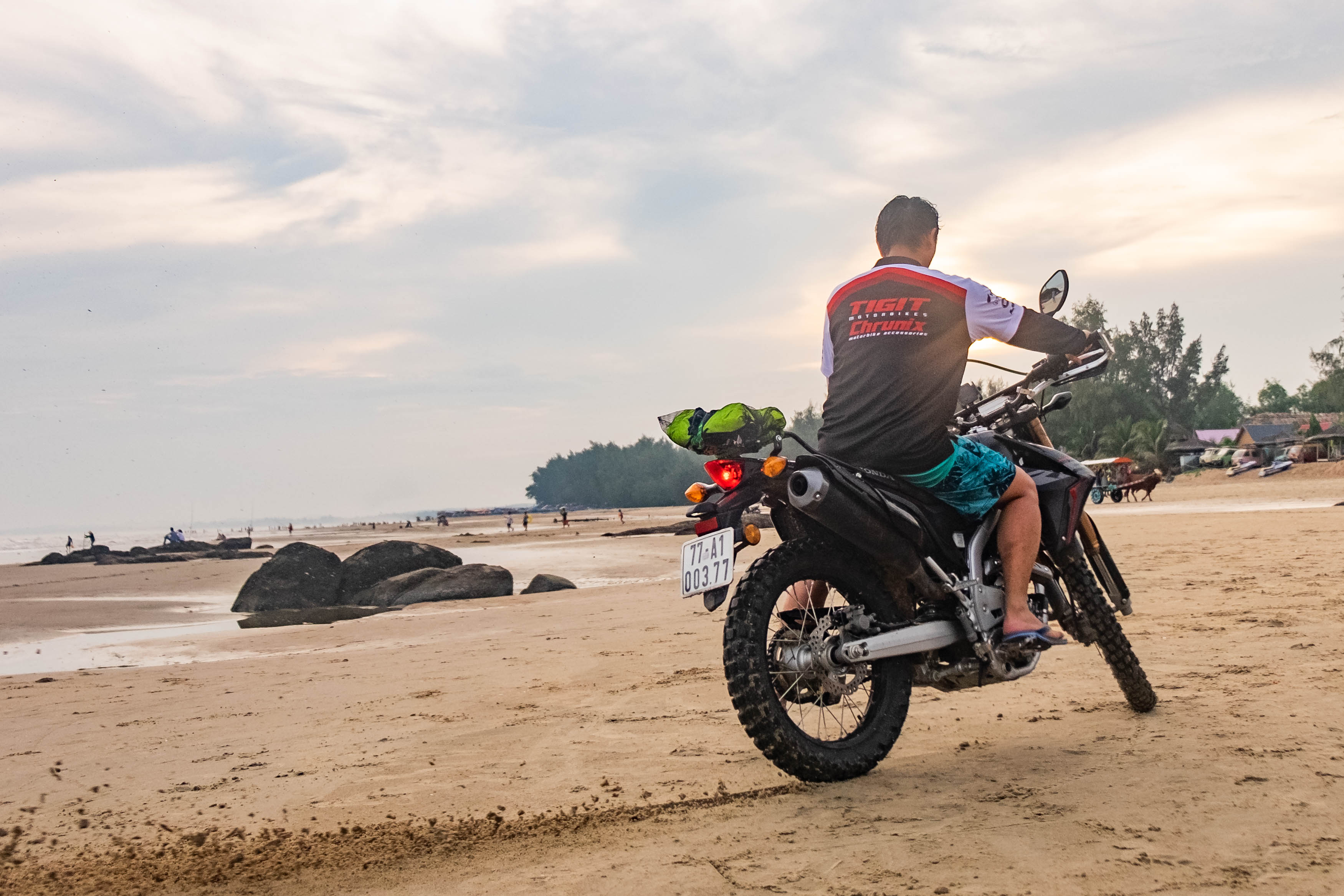
Smaller scooters like the Honda Blade 110cc will quickly transport you into riding like a local. They’re light, comfortable, and will force you to live life at a lower speed. You aren’t likely to ride more than 200-kilometers per day on a scooter.
Expectations:
- You can ride with a cheap Vietnamese style helmet
- A rain poncho for $1 or $5 will probably be fine
- Jeans and a jacket should be ample safety protection
Medium motorcycles like the Honda XR 150cc will give a choice to ride like a local or to some degree, like a professional. These bikes are a bit faster, can carry more and should be treated with the full respect you’d offer any motorbike back in your home country. The Honda XR 150 in the right hands can be wielded around like a high-performance monster. It is astonishing what this motorbike can do.
Expectations:
- You need to diligently keep to your pre-made plan, are you going to play by the rules and keep it casual, or are you going to put that throttle down hard?
- Depending on the above choice, travel light and casual, or gear up like any high-performance machine
Large motorcycles (for Vietnam) like the Honda CRF 250cc or Honda CB 500x are the choice of experienced riders. XR 150cc can fall into this category too. These bikes can carry more luggage, handle nearly anything off-road, and are capable of fast (for Vietnam) speeds.
Expectations:
- A proper full-face helmet is a must. For safety, comfort, and to keep the wind out of your helmet.
- You’ll need to bring proper rain gear and proper gear in general.
- Wielding a 500cc motorbike around Vietnam is a different game to back home. It is common for travelers booking these motorbikes to realise that what they can drive back home, is suddenly out of their comfort zone in Vietnam.
Check out our complete list of motorcycle rentals.
Packing electronic gear and laptops
Laptops
Generally, laptops and other electronic gear should be considered too heavy to bring on a motorbike journey. Modern mobile devices are extremely powerful, and unless you rely on a laptop for technical work, we strongly recommend leaving it at home.
Packing laptops is difficult, strapping them to the motorbike without damaging them is difficult, keeping them dry is difficult, and above all, they are heavy.
Electrical gear in general
Pick up your charger or any other random electrical item. It is surprising how heavy they are. Kit yourself out with one decent charger and one high-quality cable. Don’t throw all your cables in a bundled mess. Sort them out and simplify into one. If you break something on the journey, then Vietnam has plenty of electrical stores to find a replacement.
GoPro’s / Video cameras
It is common for travelers to carry Go Pro’s with them. A lovely idea to capture the moment and make the video. However, the reality is that few people know how to use them, and few know how to edit videos.
Creating a story out of a holiday is a difficult process. Storing the data is also a challenge; ultimately, it requires practice, skills, and a lot of know-how. If you don’t have any experience with movie-making, then consider the realistic chances of producing a piece of content out of what you capture. Sometimes it is best to put the cameras away and enjoy the experience the old-fashioned way, where you are completely in the “now”, and not distracted trying to capture everything.
Cameras
Cameras are heavy, and they are also challenging to get out and wield around efficiently when on a motorbike. A camera guy will always be a camera guy, and if that is you, then great, you already know what you are doing. Tigit Jon has no skills with cameras, but we equipped him with the Sony RX0 camera. Since then, the pictures on the Tigit website have been almost “professional”. He loves it, and we recommend any adventure traveler to carry one. We are always on the lookout for amazing photos and travelogues about your Vietnam adventure so be sure to share them with us, and you might end up on the Tigit Blog!
Tropical rain + electronics
Rain gear
Rain gear is one of the hardest things to get right when out on an adventure holiday. The Vietnamese rain poncho can be purchased for $5 from all Tigit offices. However, for anything above a 110cc motorbike, they are impractical. They flap around in the wind and make weird and wonderful noises as you drive along. Depending on the model of motorbike you choose, there is also a chance they melt on the engine or exhaust of the motorbike.
Cheap rain gear tends not to be breathable. Vietnam is primarily hot and humid, with rain coming and going with every mountain corner you go around. Dealing with cheap non-breathable rain gear can lead to being drenched from the inside out from sweat instead of rain.
Authentic breathable rain gear tends to come in the form of Gore-Tex jackets which cost $300 upward. For most, this is out of budget, and for many, the risk of damaging these expensive items with a motorbike crash may not be worth it.
Specifically made Gore-Tex motorbike gear costs around $600 for the jacket alone. You also need to get trousers to go with it!
What we advise
Most people should have rain gear for those rainy days back home. Please bring it with you as you already know it and trust it. Don’t fall for the fake “North Face” gear in Vietnam.If you don’t want to bring your rain clothes from home, then we recommend the Race FX rain jacket for your top half. The bottom half, we are still not sure what to suggest!
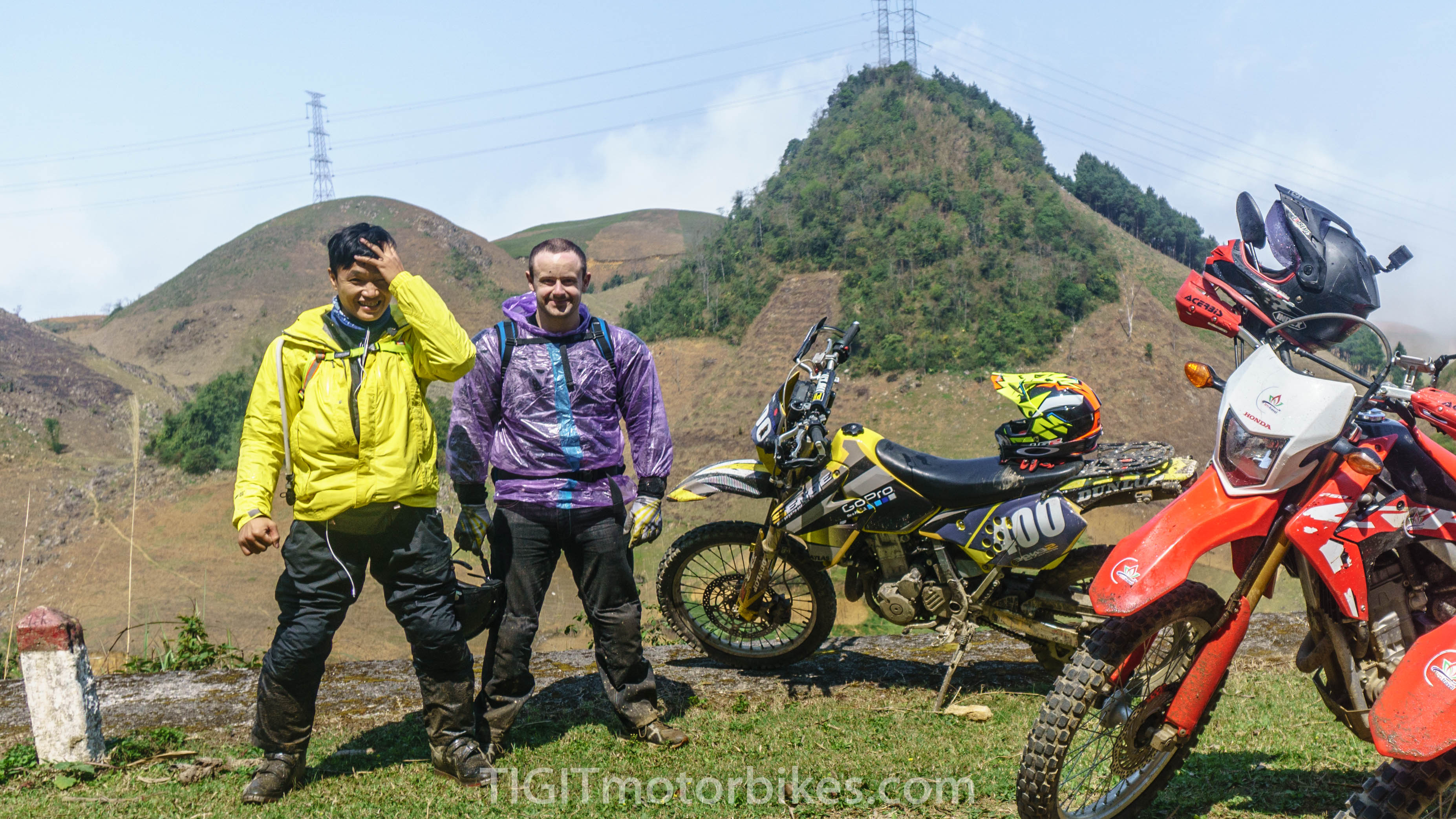
Safety Gear
Helmet
Helmets range from $1 and upward in Vietnam. Basically, you need to have something on your head. At Tigit, we give out free second-hand helmets from the brand Napoli. We keep the helmets in good condition and often throw away the old ones and replace them with new ones. Tigit is confident that our helmets are significantly higher quality than the competitors. However, helmet quality in Vietnam is very low, so this is saying little.
Tigit has an extensive range of ECE and DOT-certified helmets for sale to tackle the low standard of Vietnamese helmets, starting at around $75. We also rent out LS2 rapid fully-face helmets, which can be chosen through the booking platform when selecting a motorbike.
Girls with small heads will struggle to find a local helmet that fits. None of our free helmets are likely to fit size S people. For girls who think they are a size S, you need to purchase an LS2 helmet or rent one if you want one that fits. We can not find any good quality size S helmets on the local market.
If you have a helmet at home, then you should bring it!
Boots
Boots are considered the second most crucial safety item after the helmet. Motorbikes are heavy, and when they fall on you, they trap your leg at speeds that can lead to a broken leg/ankle. However, most European motorbikes weigh 200KG and up (Honda CB 500x), whereas little motorbikes commonly found in Vietnam, like the Honda XR 150 weigh just 130KG.
Boots also protect from rocks and shrapnel flying up from the motorbike. For a holiday of plodding along tarmac roads at very gentle speeds (60km/h), boots are definitely an optional extra. Be it a 110cc Honda Blade or a 150cc Honda XR. The motorbike boot is not necessarily needed for Vietnamese-style road speeds.
However, once you step up into serious driving or offroading or plan on traveling at some speed, then the motorbike boot is an absolute must. For anything above 150cc we strongly recommend a motorbike boot.
Tigit stocks the Fly Maverik boot, which is a very competitively priced boot globally.
Knee pads / Elbow pads
The third most important safety item to get hold of is knee and elbow pads. These come in hard form (Ls2 knee pads) and soft form (Forcefield Pro Tube). Both have pros and cons, but comfort is key for a long adventure holiday. Tigit Jon highly recommends the Forcefield Pro-Tube, the highest quality CE level 2 armour on the market today.
For $100 a set (knee), these are a must-have item for anyone on a motorbike.
Back, front and elbow protectors
Opting for back, front, and elbow protection is going the extra mile in terms of safety gear. Again, Jon recommends under armour, such as the ForceField Pro shirt, over and above traditional ADV-marketed jackets and suits.
Gloves
Gloves are available for $10 and upward. There is no need to splash out on expensive gloves. Just get something that feels comfortable and fits. The primary objective of the glove is to protect your hands from wear and tear on the handlebar grips. A bonus is some protection on hitting the floor.
The Top half Jackets / coats
A jacket is needed to keep you warm on the journey across Vietnam, regardless of the season. When looking at jackets, it is best to try and avoid bulky items that take up lots of luggage space, such as puffer jackets.
Any warm jacket you have back home, combined with ForceField under armor (if you choose to go safe), is sufficient.
This allows you to take off your jacket or put it back on again quickly and efficiently without worrying about the armor being attached to the jacket.
The Top half T-shirts
A T-shirt is fine for the casual driver, but there are obvious risks of tarmac burn in the case of a crash.
Tigit Jon uses the ForceField Pro Tube to protect from crashes and road burn. To protect both himself and the Pro-tube from the outside world elements, Tigit Jon will use a long sleeve motocross T-shirt. Motocross T-shirts are incredibly lightweight and breathable. They are great for hot temperatures and also quick drying when they get wet.
When in Vietnam, cover up at all costs. This saves on suncream and saves on sunburns.
Trousers
Covering your bottom half is easier said than done. Traditional armored ADV gear is hot, heavy, and expensive. Protected jeans or just jeans in general, are hot and useless in the wet. Shorts should be a no go for everyone. Don’t drive a motorbike in shorts and a T-shirt.
If you don’t want to spend money on extra gear, wear any long trousers. Jeans are the best, but basically, anything you decide. However, any household gear combined with the Pro Tube can resist tarmac abrasion.
The Pro Tube acts as a sponge that will stop your slide in its tracks.
Tigit sells motocross trousers and armored jeans in all our stores.
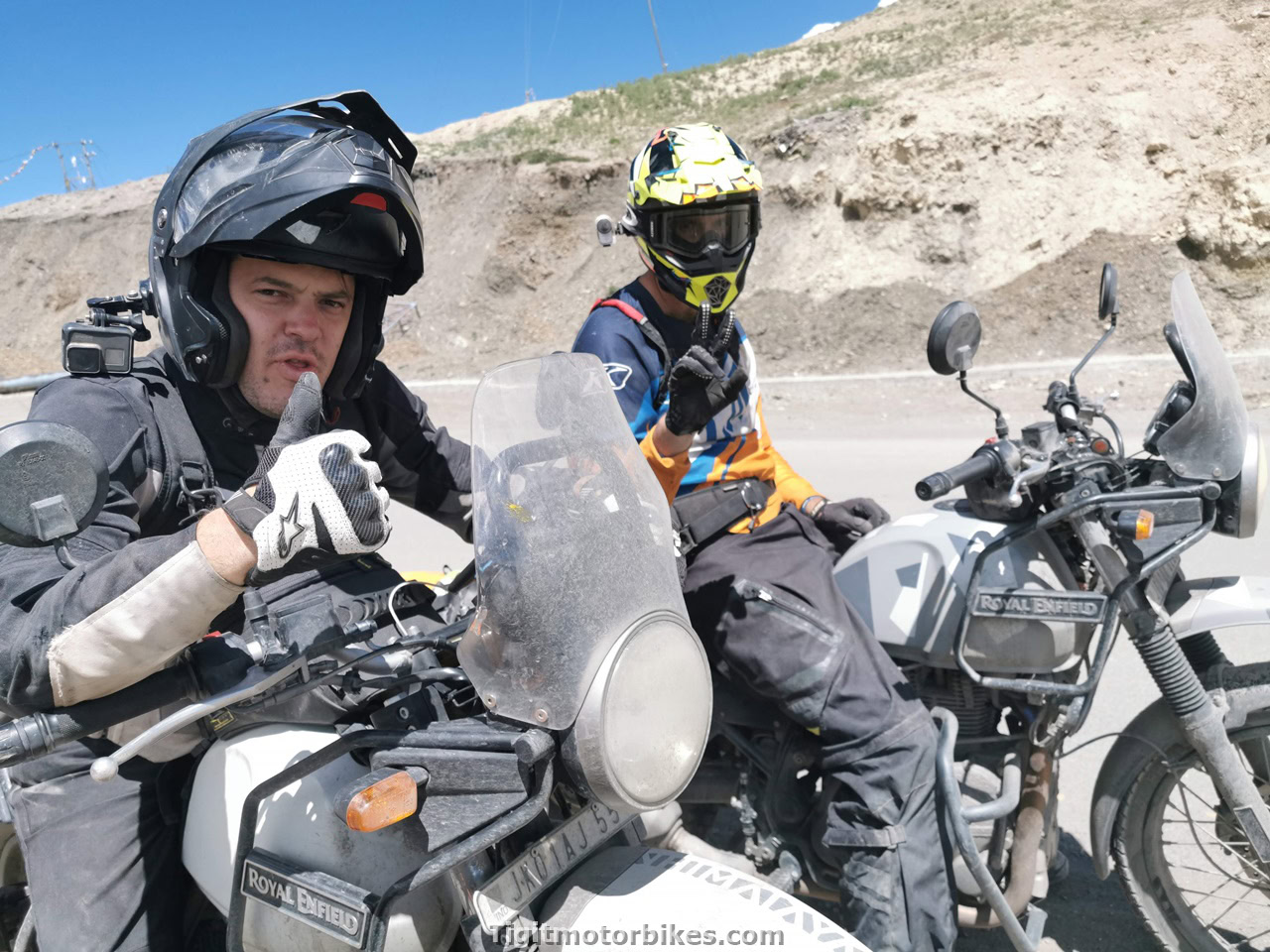
Socks
There is no avoiding wet feet. All brands of “waterproof” motorbike boots fail, wet feet are a guarantee. If using trainers, then just carry several socks.
Long socks are a good idea if you have a set of motorbike boots. Tigit carries motocross socks which are breathable and offer protection from the rub of a motorbike boot.
The locals will use plastic bags over their shoes when it gets wet This is a great solution. The major downside is that plastic bags are not breathable so your feet get hot quickly. It also looks weird, but maybe that is part of the journey!
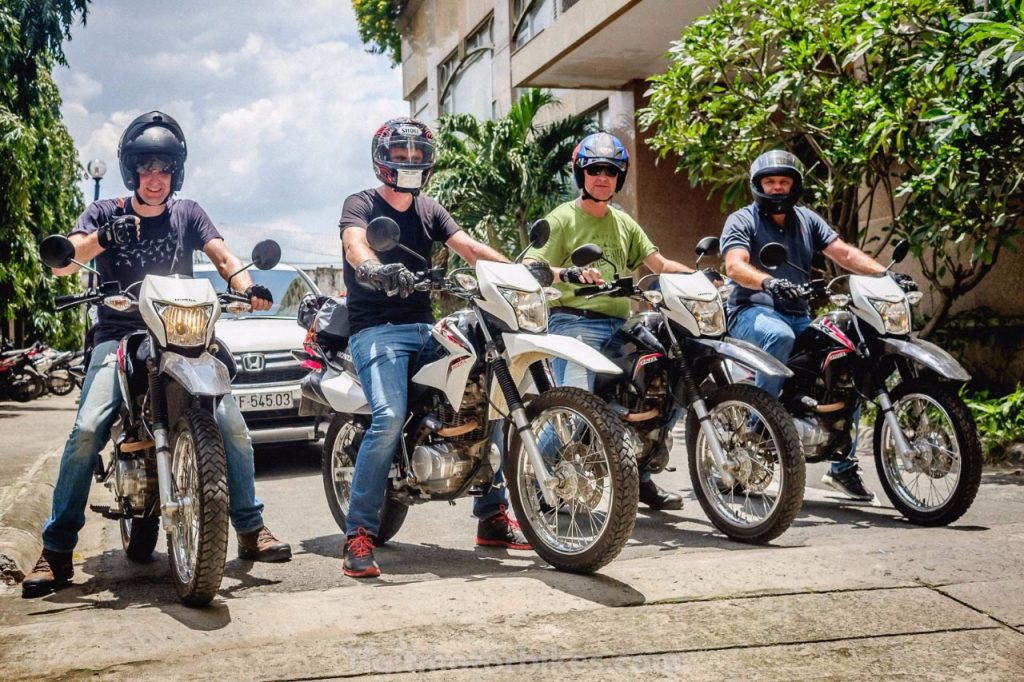
Here’s a group of four riders from New Zealand on some good looking Honda 150s. These kiwis from their sparsely populated island are about to see more traffic than they have in their lives!
Helmet Rentals
ECE (European certified) LS2 road helmets Please request rental in advance.
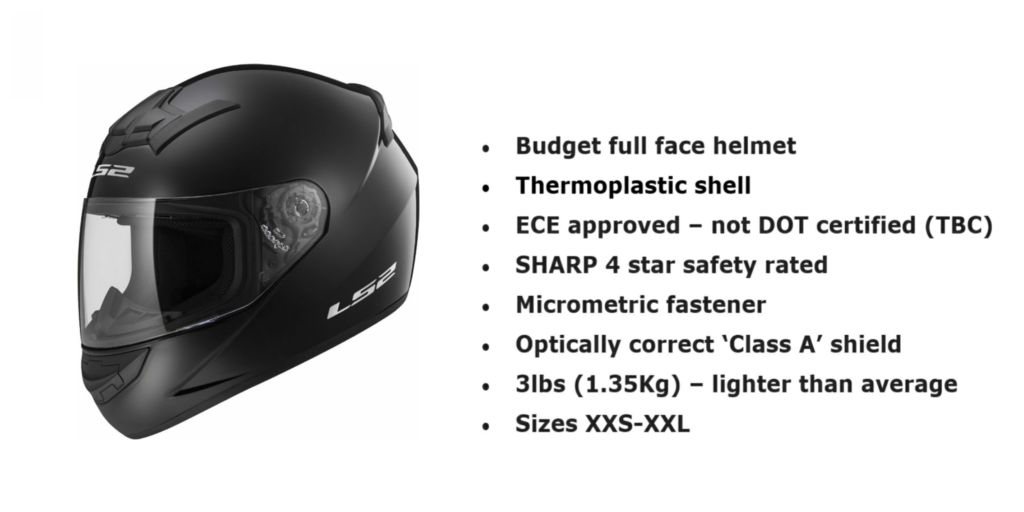
Jacket, Knee and Elbow Protectors Rentals
Tigit Motorbikes (upon request) has CE certified safety vests and knee pads.
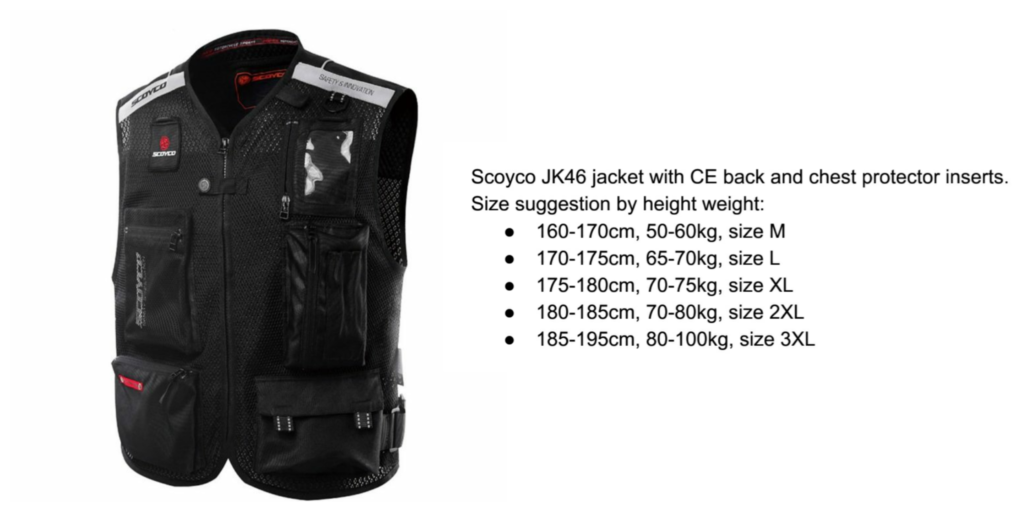

For a look into our body protection gear, check out our Tigit body protection sales page.We’ve recently compiled a buyers guide for motorbike safety gear in Vietnam too.
The Weather and How To Plan For It
Seasons
We have a full article explaining Vietnams weather. March and April are the best times to travel Vietnam. Across the country, the weather conditions are mostly stable.
- The South is always hot. Think 30oC, riding your Honda XR150 to the beach in Vung Tau.
- The North from November to February can be very cold.
- From the South to central Vietnam, the rainy season is July to October.
- Mid Vietnam cyclone season runs from around September to December. Not a regular occurrence, but it happens. Picture two days waiting out a storm.
Despite thinking you should only plan your trip around the hot areas during the dry times of the year. Each season can offer some benefits, and if you plan to ride the length of the country, you are likely to run into a myriad of weather differences.
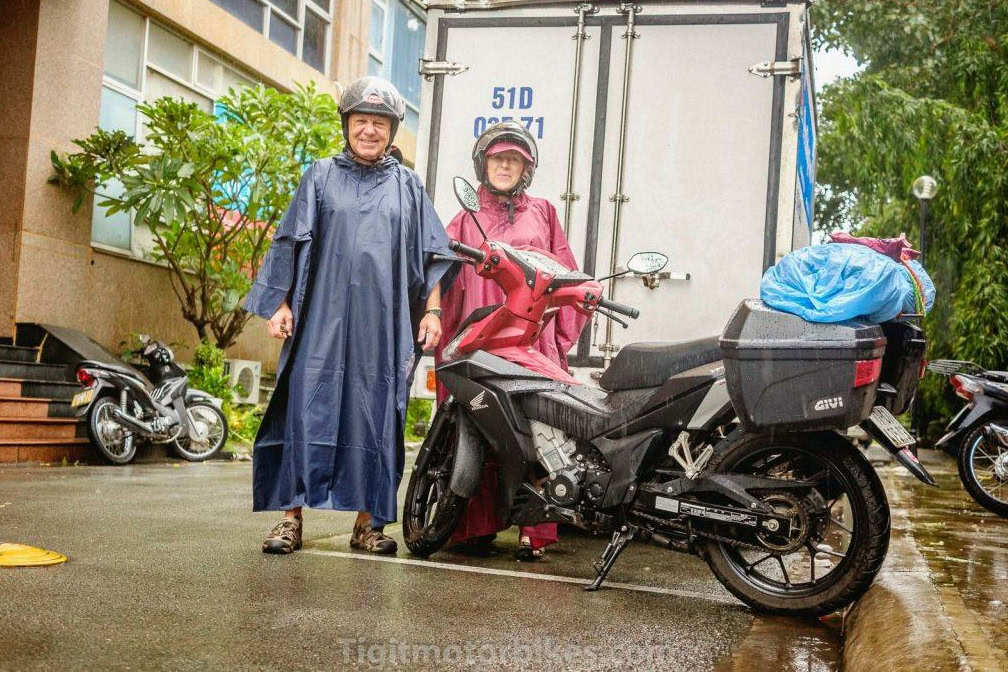
The Vietnamese rain Poncho at $5, mostly does the job
Water & Staying Hydrated
When adventure riding with your motorbike rental , water bottles become loose and fall off. If they are strapped to your seat, they will eventually become hot, unrefreshing water that tastes like melted plastic.
After years of running the roads of Vietnam, we’ve found that it’s nearly impossible to stay hydrated without easy access to water while you’re riding.
You’ll slowly sweat, become fatigued, and likely get a headache.
- Solution A: If you are driving casually across the country you can stop and continually buy bottles of water.
- Solution B: The hydration pack. This pack has become our single most important tool when riding across Vietnam. Fill it with water, strap it on, and enjoy easy-drinking pleasure while riding your motorcycle.
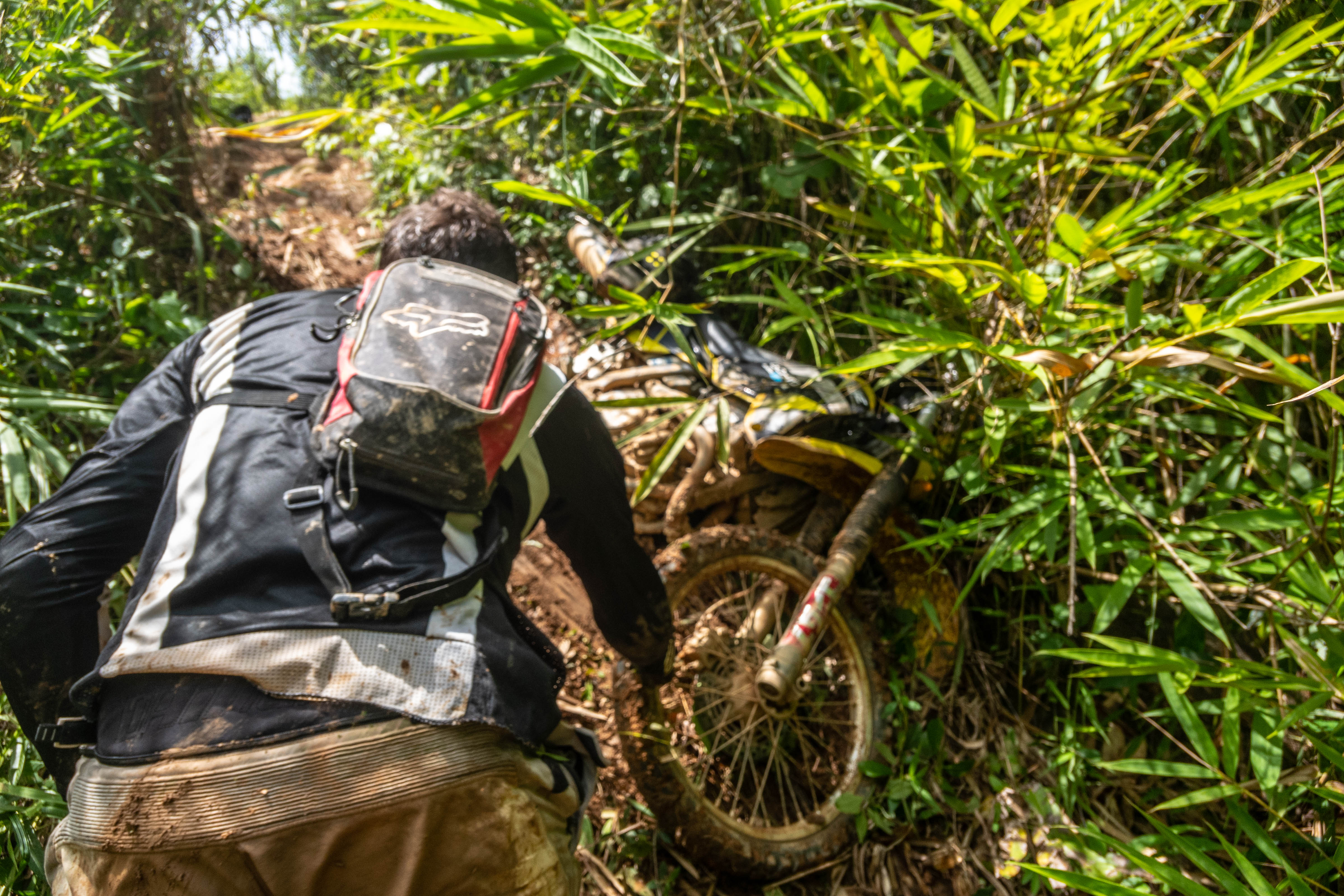
Things To Consider:
- Decide on the holiday that you are going for and pack appropriately
- Pack light. No one has ever complained about having a light load
- Vietnam is slow, very slow. You’ll be covering less ground than you think
- If you are on an off-road mission or trying to cover as much ground as possible, then get the safety gear and throw away your luggage
- Don’t compare your ideas to those of typical backpackers. Motorbikes can move here with the right person wielding the beast
- Under pack and use those washing services along the way.
- Minimizing luggage improves the motorbike performance and is easier to load on and off the motorbike each day
- Heavily loaded motorcycles will have reduced handling and increased braking distances
- Vietnam is cheap for shopping, so if you are missing an item of clothing that should have been packed. Those missed items can be picked up easily and cheaply nearly anywhere in the country
- A traveler is likely to experience all weather conditions on one holiday. It is not possible to predict the weather
- Have fun. Vietnam is a giant playground unlike any other on earth
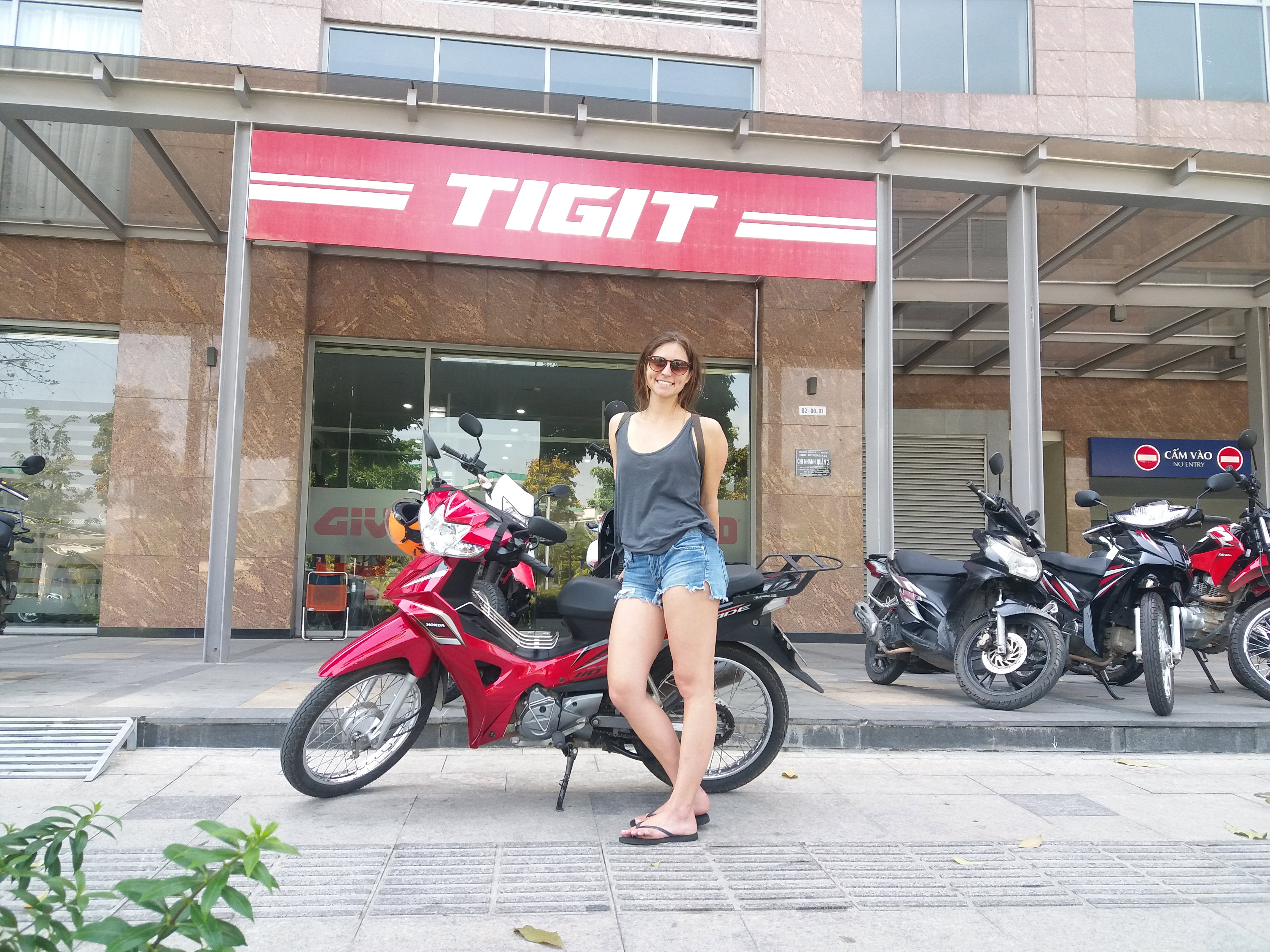
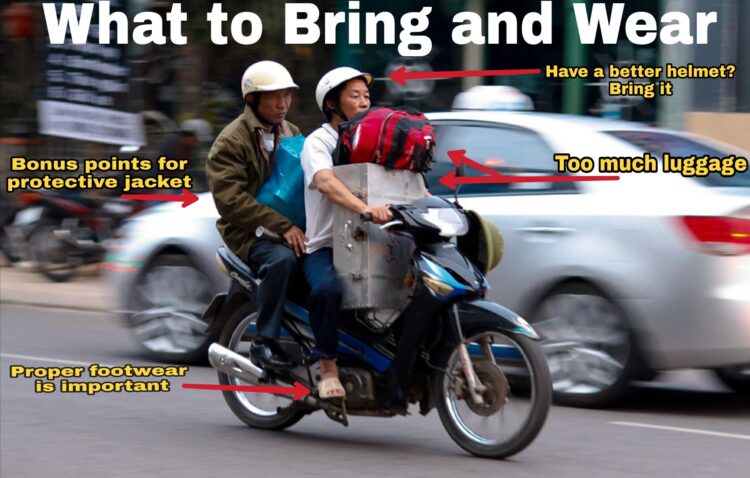
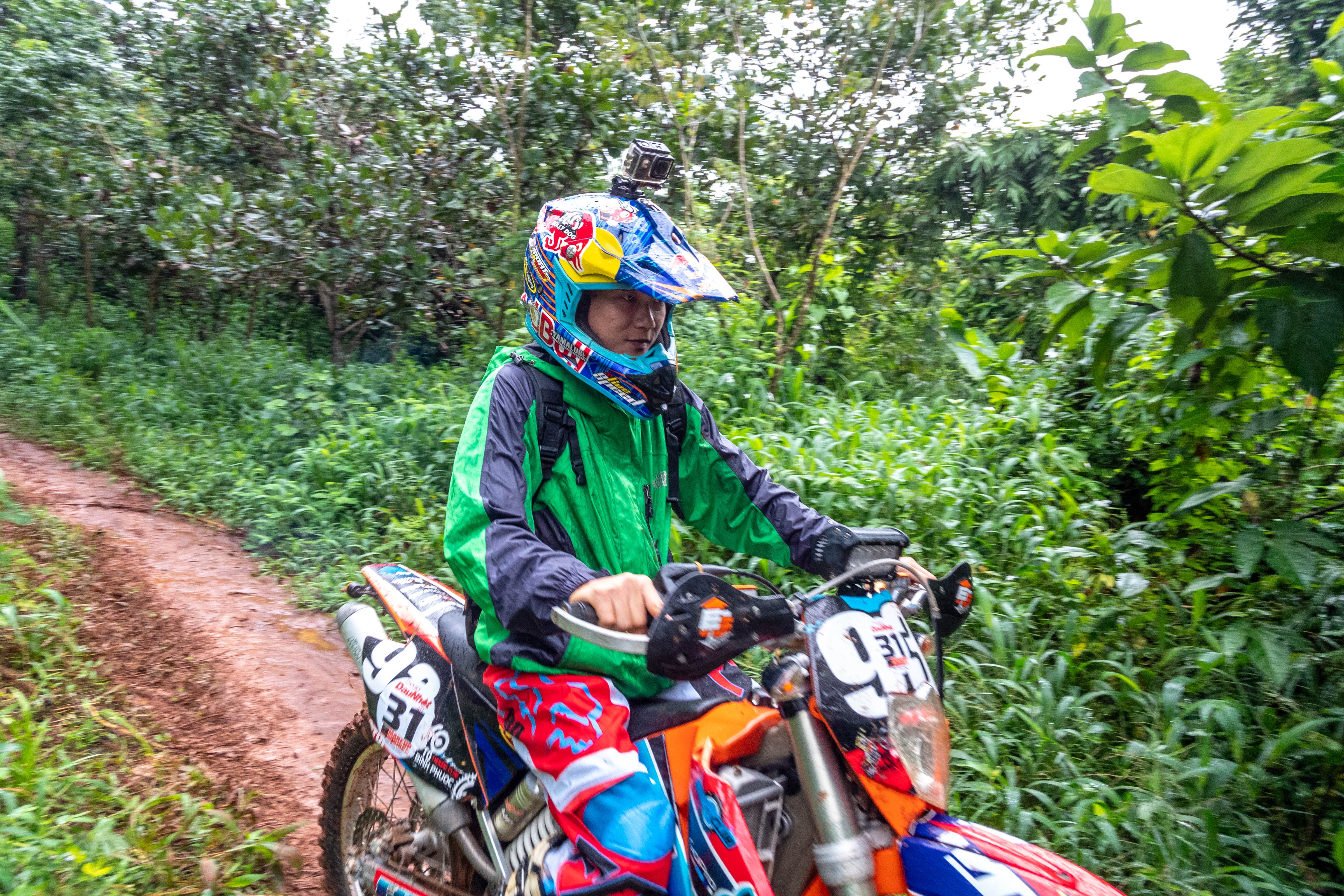

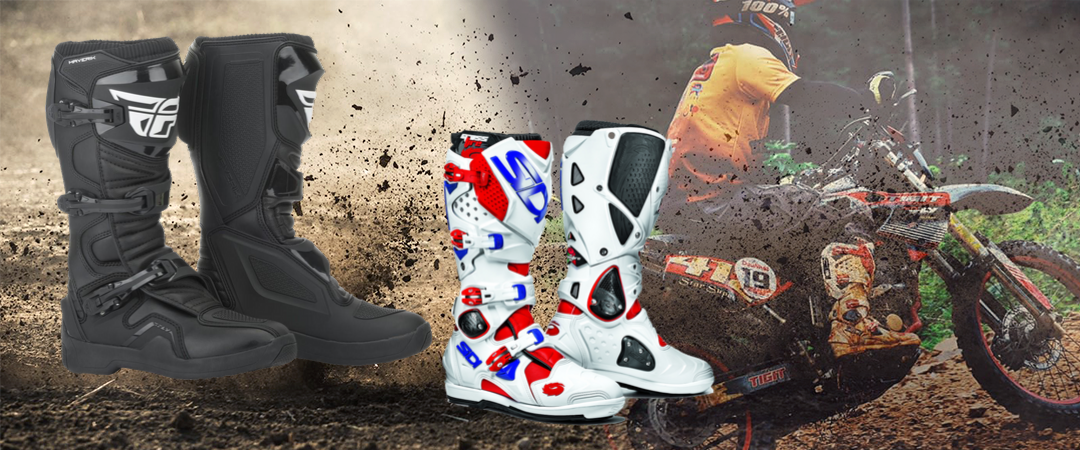

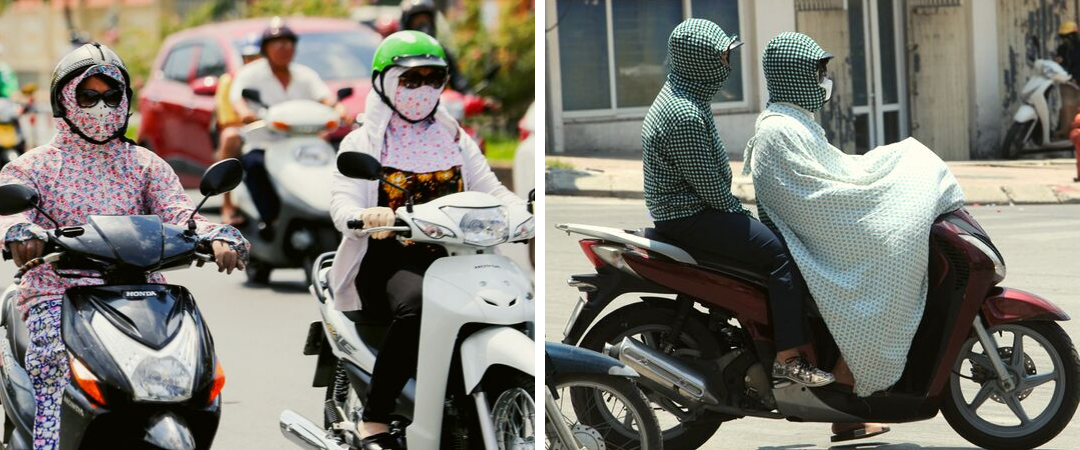






















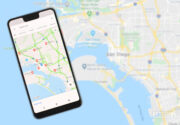

Great video on what you pack…but:
Do you not take a tube patch kit or tube, and tire iron? and a means to inflate your tires? I did see a pressure guage.
You mention sun cream, but no tooth brush/paste? No first aid ie: band aids, panadol? ear plugs to save your hearing on the road? no hat?
It almost looks like you are/were on supported trips or am I missing something?
Fair comments.
Big bikes in Vietnam you need to carry tubes, but not repair gear. There are so many mechanics here that there is no need to fix a flat yourself.
You are right on the medication though and it should be added to the list. I do carry very basic medical gear.
No ear plugs, I love the sound of the bike.
But no in general very light. I don’t carry shoes for example. I use the hotel flip flopts (provided in every hotel in Vietnam). If it was an overseas trip, I will invest in those slipper shoes for next time. Carrying around trainers is too bulky.